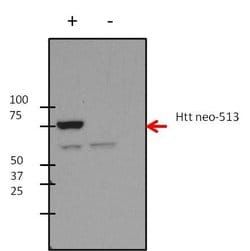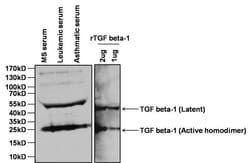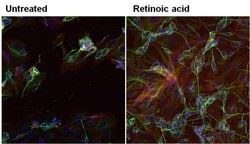Huntingtin Monoclonal Antibody (3-19), Invitrogen™
Manufacturer: Thermo Scientific
Select a Size
| Pack Size | SKU | Availability | Price |
|---|---|---|---|
| Each of 1 | PIMA1115-Each-of-1 | In Stock | ₹ 44,544.50 |
PIMA1115 - Each of 1
In Stock
Quantity
1
Base Price: ₹ 44,544.50
GST (18%): ₹ 8,018.01
Total Price: ₹ 52,562.51
Antigen
Huntingtin
Classification
Monoclonal
Concentration
1 mg/mL
Formulation
PBS with 1mg/mL BSA and 0.05% sodium azide
Gene Accession No.
P42858, P42859
Gene Symbols
Htt
Immunogen
Synthetic peptide conjugated to KLH via cysteine corresponding to residues C-HTLQADSVD (505-513) of Human HTT.
Quantity
100 μg
Primary or Secondary
Primary
Target Species
Human, Mouse
Product Type
Antibody
Isotype
IgG
Applications
ELISA, Immunocytochemistry, Immunohistochemistry, Western Blot
Clone
3-19
Conjugate
Unconjugated
Gene
Htt
Gene Alias
AI256365; C430023I11Rik; Hd; HD protein; HD protein homolog; Hdh; HTT; Huntingtin; huntingtin (Huntington disease); Huntingtin, myristoylated N-terminal fragment; Huntington disease gene homolog; huntington disease protein; huntington disease protein homolog; IT15; solute carrier family 6 (neurotransmitter transporter, serotonin), member 4
Host Species
Mouse
Purification Method
Affinity chromatography
Regulatory Status
RUO
Gene ID (Entrez)
15194, 3064
Content And Storage
-20°C
Form
Liquid
Description
- MA1-115 has been successfully used in immunofluorescence, immunohistochemistry, Western Blot, and ELISA applications with human and mouse samples
- Neoepitope antibodies distinguish smaller cleaved fragments or processed forms of proteins versus the intact full-length or precursor by using a designed peptide purification process to maximize immunoreactivity to a specific cleavage site
- Human HTT caspase cleavage sites generate fragment-specific forms of the protein
- Caspase-3/7 has been shown to generate cleavage sites at animo acids 513 and 552
- Caspase-2 cleaves at amino acid 552 and caspase-6 at amino acid 586
- Neo-specific antibody MA1-057 recognizes the 513 cleaved fragment without detecting the full-length form
- Huntingtin is a disease gene linked to Huntington's disease (HD), a neurodegenerative disorder characterized by loss of striatal neurons
- This is thought to be caused by an expanded, unstable trinucleotide repeat in the huntingtin gene, which translates as a polyglutamine repeat in the protein product
- HD is a mid-life onset autosomal dominant neurodegenerative disease that is characterized by psychiatric disorders, dementia, and involuntary movements (chorea), leading to death in 10-20 years.The huntingtin locus is large, spanning 180 kb and consisting of 67 exons
- The huntingtin gene is widely expressed and is required for normal development
- It is expressed as 2 alternatively polyadenylated forms displaying different relative abundance in various fetal and adult tissues
- The larger transcript is approximately 13.7 kb and is expressed predominantly in adult and fetal brain whereas the smaller transcript of approximately 10.3 kb is more widely expressed
- The genetic defect leading to Huntington's disease may not necessarily eliminate transcription, but may confer a new property on the mRNA or alter the function of the protein.



